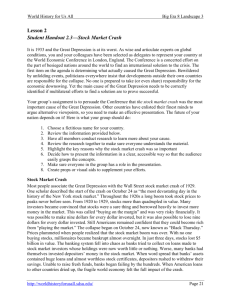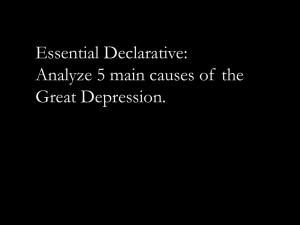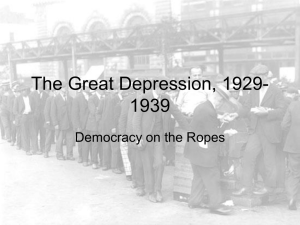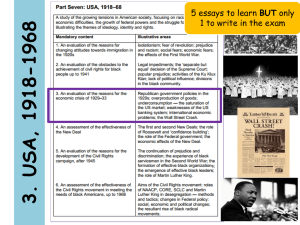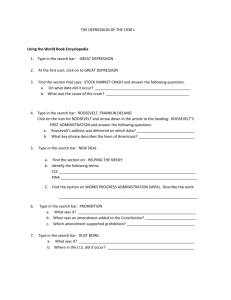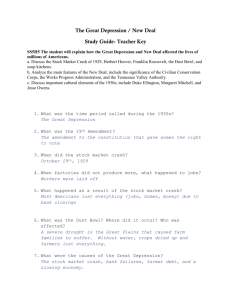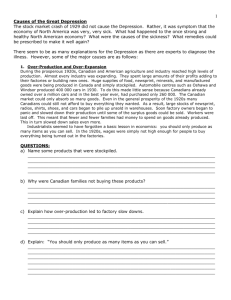Causes of the Great Depression
advertisement
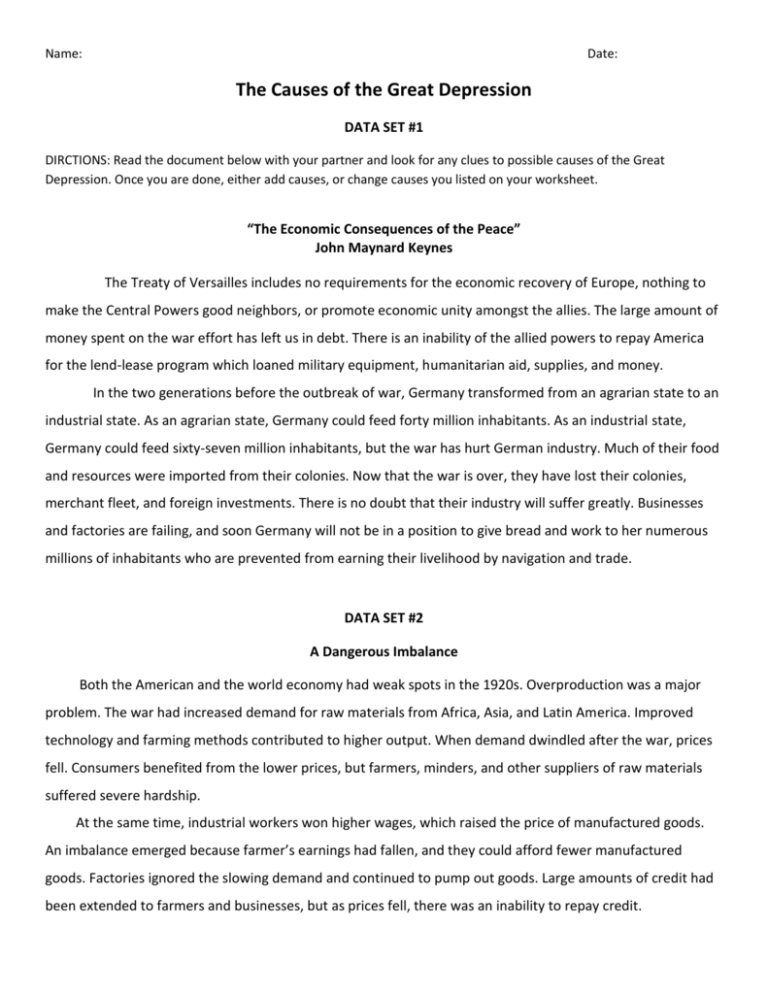
Name: Date: The Causes of the Great Depression DATA SET #1 DIRCTIONS: Read the document below with your partner and look for any clues to possible causes of the Great Depression. Once you are done, either add causes, or change causes you listed on your worksheet. “The Economic Consequences of the Peace” John Maynard Keynes The Treaty of Versailles includes no requirements for the economic recovery of Europe, nothing to make the Central Powers good neighbors, or promote economic unity amongst the allies. The large amount of money spent on the war effort has left us in debt. There is an inability of the allied powers to repay America for the lend-lease program which loaned military equipment, humanitarian aid, supplies, and money. In the two generations before the outbreak of war, Germany transformed from an agrarian state to an industrial state. As an agrarian state, Germany could feed forty million inhabitants. As an industrial state, Germany could feed sixty-seven million inhabitants, but the war has hurt German industry. Much of their food and resources were imported from their colonies. Now that the war is over, they have lost their colonies, merchant fleet, and foreign investments. There is no doubt that their industry will suffer greatly. Businesses and factories are failing, and soon Germany will not be in a position to give bread and work to her numerous millions of inhabitants who are prevented from earning their livelihood by navigation and trade. DATA SET #2 A Dangerous Imbalance Both the American and the world economy had weak spots in the 1920s. Overproduction was a major problem. The war had increased demand for raw materials from Africa, Asia, and Latin America. Improved technology and farming methods contributed to higher output. When demand dwindled after the war, prices fell. Consumers benefited from the lower prices, but farmers, minders, and other suppliers of raw materials suffered severe hardship. At the same time, industrial workers won higher wages, which raised the price of manufactured goods. An imbalance emerged because farmer’s earnings had fallen, and they could afford fewer manufactured goods. Factories ignored the slowing demand and continued to pump out goods. Large amounts of credit had been extended to farmers and businesses, but as prices fell, there was an inability to repay credit. Many nations attempted to nationalize their economy. In order to protect industry, they imposed tariffs, a tax on imported goods. By taxing imported goods, it raises the price and encourages the purchase of goods from within a country. The United States imposed the highest tariffs in history, and many European countries responded by raising their own tariffs. In the end, all countries lost access to the larger global market. DATA SET #3 The Crash of 1929 The market dropped sharply at the beginning of the month but rose again only to drop and rise again. The rollercoaster ride continued in October as the beginning of the month saw another drop followed by another burst of strength. Then came Black Thursday – October 24 – when a drop in stock prices triggered a burst of panic-selling so frantic that it overwhelmed the Stock Exchange's ability to keep track of the transactions. Wall Street financers were able to reverse the downward plunge only by buying as many shares of stock as they could over the next two days. It was a temporary victory. Monday's opening bell unleashed a frenzy of selling that soon turned into an uncontrolled panic that continued for the rest of the trading day. The following day – Black Tuesday, October 29 – saw the previous day's panic turn into bedlam on the trading floor. According to one observer, traders "hollered and screamed and clawed at one another's collars. It was like a bunch of crazy men. Every once in a while, when Radio or Steel or Auburn would take another tumble, you'd see some poor devil collapse and fall to the floor." This was the Crash, although few could see it at the time. The Market continued its decline but never as dramatic. Thirty billion dollars had been lost - more than twice the national debt. The Stock Market Crash launched America and a world into chaos. Banks demanded a repayment of loans which people could not afford. Money seemed to disappear. The economic situation in America made the European economy even worse. America, faced with its own financial crisis, could no longer afford to give loans to other countries. Name:_________________________________ Date:_________________ Period:_______ DIRECTIONS: Work with your partner to complete the following tasks. Write down any causes that you think might have caused Worldwide Depression in the 1930’s Data Set #1-List any new causes you found in the reading. Did the document mention a cause you already listed above? Which ones? Data Set #2-List any new causes you found in the reading. Did the document mention any causes you already listed? Which ones? Data Set #3-List any new causes you found in the reading. Did the document mention any causes you already listed? Which ones? Causes and Effects of the Great Depression Long-Term Causes Immediate (Short Term) Causes Immediate (Short-term) Effects Long-Term Effects • Huge debt resulting from WW I • Stock Market Crash of 1929 • Vast unemployment and misery • Nazis take control of Germany • European Dependence on American Loans • Widespread use of credit • Banks demand repayment of • Bank Failures loans and collapse of credit • Americans can no longer give • Loss of faith in loans to other capitalism and countries democracy •Overproduction of goods paired • Businesses and • Authoritarian with a decline in factories fail leaders gain demand support • High protective tariffs • Scapegoats are blamed for economy • Fascist leaders gain control of Eastern Europe • World War II begins
